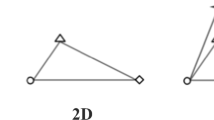Abstract
A general description is given of the mathematical modelling of physical properties of liquid mixtures, with an emphasis on the early progress in mathematical representation of mixtures’ thermodynamics. The core issue is employing long polynomials to represent mixing data accurately, without having to optimise a large number of independent parameters. This is for instance done by deriving the long polynomials from explicit (analytical) models with few independent parameters. It is shown that this field evolved not by gradual changes in model complexity and accuracy, but rather in bursts, followed by pausing for several years or decades whenever researchers hit computational or conceptual limitations. One such limitation that still exists is the Taylor expansion of the above mentioned analytical models. This article presents a novel use of Pascal’s triangle that turns this computationally “hard” problem into a trivial iterative procedure, suitable for standard office spreadsheets. The process of transforming this hard problem into a soft problem may be described as deciphering. The present author conjectures that for every parametric function for which a polynomial expansion can be made, there is a corresponding coefficient pattern involving Pascal’s triangle and/or other binomial sequences and matrices.
Similar content being viewed by others
References
Marczak W. (2002). Phys. Chem. Chem. Phys. 4: 1889
Herzfeld K.F., Heitler W. (1925). Zeit. Electrochemie. 31: 536
Guggenheim E.A. (1935). Proc. Roy. Soc. A. 148: 304
Rushbrooke G.S. (1938). Proc. Roy. Soc. A. 166: 296
R.H. Fowler, E.A. Guggenheim, Statistical Thermodynamics, (Cambridge University Press, 1939)
Fowler R.H., Guggenheim E.A. (1940). Proc. Roy. Soc. London A. Mater. 174: 189
Wakefield A.J. (1951). Proc. Camb. Phil. Soc. 47: 419
Guggenheim E.A. (1952) Mixtures. Clarendon Press, Oxford
Hill T.L. (1960) An Introduction to Statistical Thermodynamics. Addison-Wesley, Reading MA-USA
Wagner C. (1962) Thermodynamics of Alloys. Addison-Wesley, Reading MA-USA, p. 51
Pelton A.D., Bale C.W. (1986). Metal. Trans. A 17: 1211
Pelton A.D., Blander M. (1986). Metal. Trans. B 17: 805
http://en.wikipedia.org/wiki/Pascal’s_Triangle
http://mathworld.wolfram.com/PascalsTriangle.html
Randic M., Morales D.A., Araujo O. (1996). J. Math. Chem. 20: 79
http://mathworld.wolfram.com/BinomialCoefficient.html
N.J.A. Sloane, The On-Line Encyclopedia of Integer Sequences, http://www.research.att. com/~njas/sequences/A001700
Dickson L.E. (1894). Ann. Math. 9: 73
Author information
Authors and Affiliations
Corresponding author
Rights and permissions
About this article
Cite this article
Fenstad, J. Deciphering the hidden Pascal code of Guggenheims quasichemical model. Overcoming computational limitations by use of Pascal’s triangle. J Math Chem 42, 1085–1100 (2007). https://doi.org/10.1007/s10910-007-9262-6
Received:
Accepted:
Published:
Issue Date:
DOI: https://doi.org/10.1007/s10910-007-9262-6




